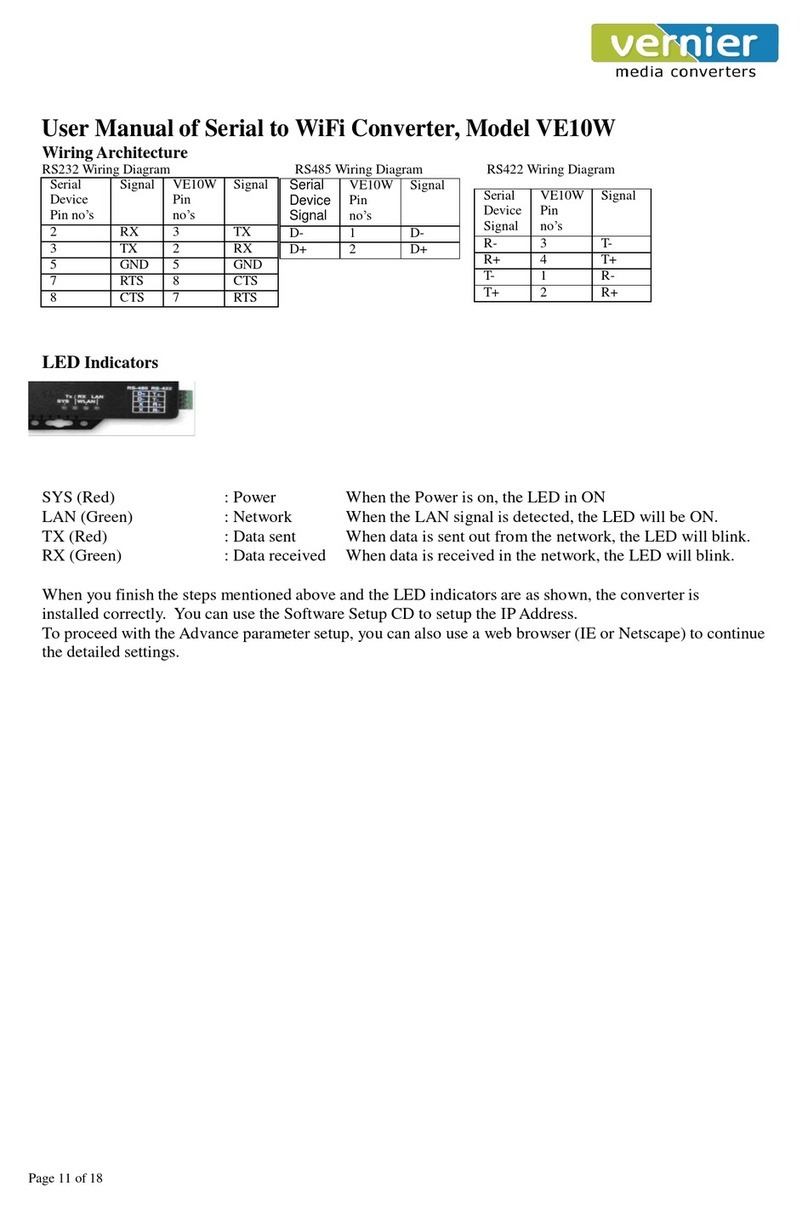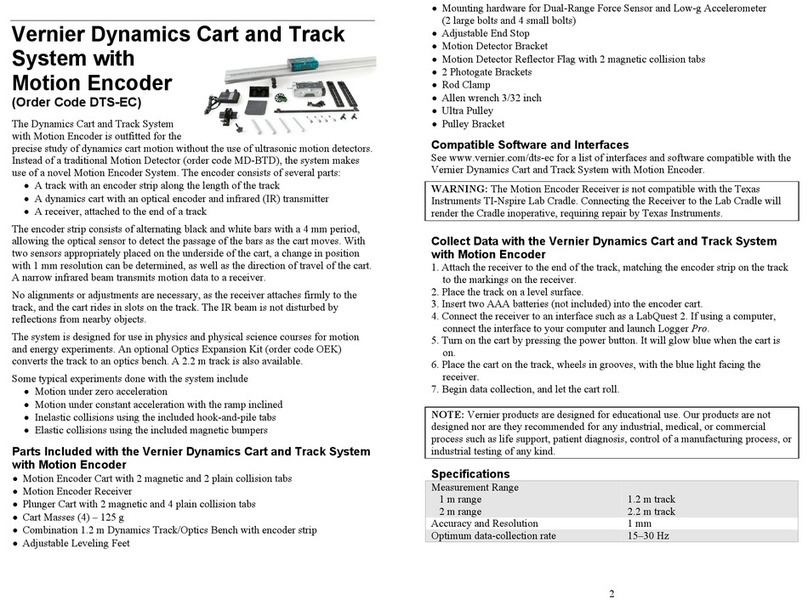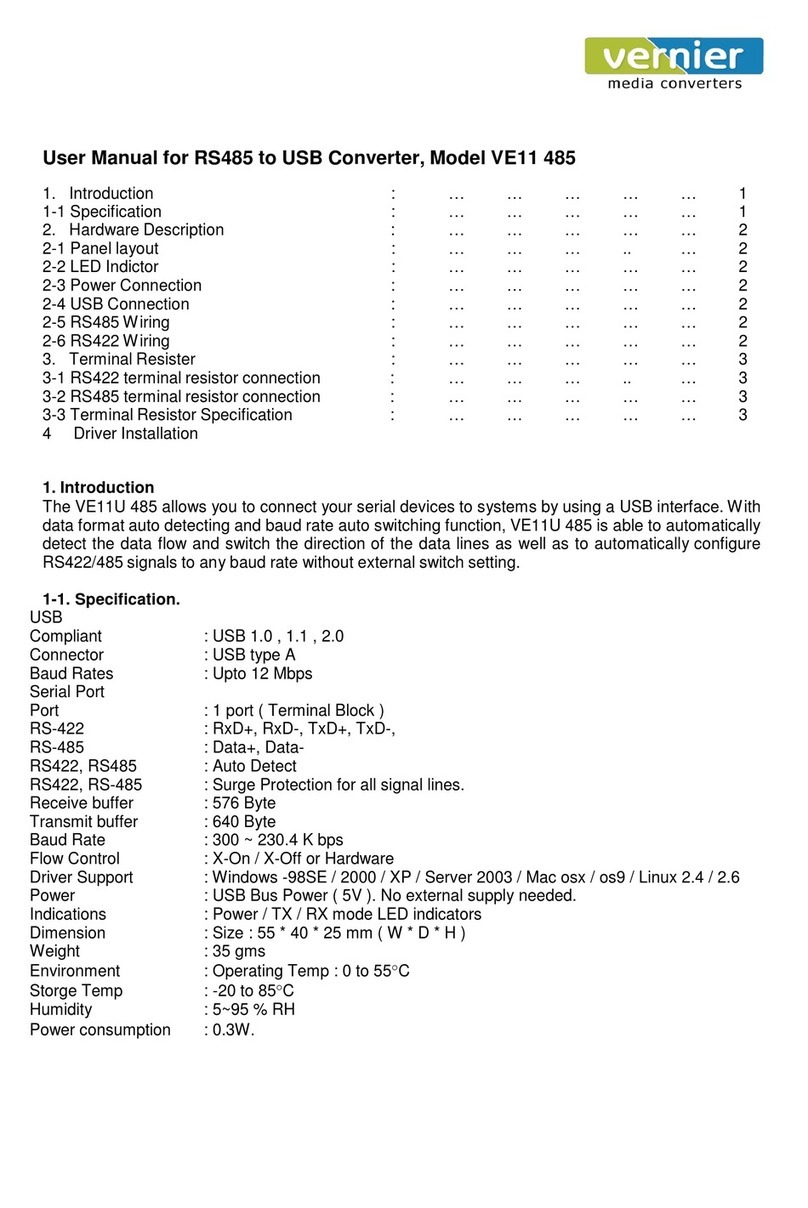
5
unobstructed receiver. A second encoder strip must be applied to the track, one on
either side of the center slot.
Consider reversing the direction of one receiver so that the same direction is positive
for each system. Put the carts together, and zero both systems. This will put the carts
on the same coordinate system; if they move together in contact, their position
readings will be the same.
Use of Multiple Vernier Motion Encoder Systems in the Same
Room
Because of the narrow IR beam used for signaling between the cart and receiver,
interference should be rare. However, if one apparatus is apparently interfering with
another, the problem can be resolved by repositioning one of the tracks.
All Motion Encoder Carts are interchangeable; that is, there is no matching of cart to
receiver.
Data-Collection Notes for the Motion Encoder System
The optical motion encoder can only make relative position measurements, so that
the zero point is initially determined by where on the track the cart is first placed
when the power is on. If you want zero to be near the receiver, initially place the
cart next to the receiver. This behavior is very different from the ultrasonic
Motion Detector, which by default uses a fixed origin near the detector.
The motion encoder is nearly immune to interference, but it cannot work if the IR
beam between the cart and receiver is blocked. Keep your hand away from this
region.
Since the zero position (origin) of the encoder depends on where the cart is placed
initially, it is often useful to zero the encoder in the software. Place the cart in the
position you want to declare as zero. On LabQuest, tap the meter display to access
the zero command. In Logger Pro, use the toolbar button.
It can also be useful to reverse the direction of the coordinate system, so that
values increase as the cart moves toward the receiver. Do this from the meter
screen on LabQuest, or by using the sensor popup menu in the Set Up Sensors
dialog for your interface on Logger Pro.
High data-collection rates are not useful for the motion encoder. Rates above
30 Hz will produce noisy velocity and acceleration graphs because of few counts
during each time period.
Just like the ultrasonic Motion Detector, it can be useful to adjust the number of
points used to calculate derivatives for velocity and acceleration graphs. Higher
values create quieter graphs, while lower values result in more temporal detail.
Adjust this value in LabQuest preferences or in the Settings for… File menu item
in Logger Pro.
Suggested Experiments with the Vernier Motion Encoder System
The Vernier Motion Encoder System can be used wherever a Motion Detector could
have been used with a cart and track. The encoder depends on the presence of the
track, so that only cart and track experiments can be performed.
6
Measure Cart Acceleration
The basic motion of a cart on a ramp can be studied. For example, perform
Experiment 3 from Physics with Vernier, “Cart on a Ramp.” Or, repeat Galileo’s
experiment of determining gusing an object and a ramp. This is Experiment 4
“Determining g on an Incline” from Physics with Vernier.
Newton’s Second Law
Use a force sensor on the encoder cart to record both applied force and acceleration.
The two will be proportional.
Or, set up a half-Atwood machine with a hanging mass and a pulley at the track end
opposite the receiver. Measure the acceleration of the encoder cart as a function of
the hanging mass.
Measure Fan Cart Acceleration
Add a Cart Fan (order code: FAN-VDS) to observe the motion of a cart under
constant thrust.
Measure Cart Acceleration with Friction
Add a Friction Pad (order code: PAD-VDS) to the encoder cart and observe the
motion of the cart with varying frictional forces.
Momentum-Impulse
Add a force sensor and a Bumper-Launcher Kit (order code: BLK) to observe the
relationship between momentum and impulse. Find the impulse by integrating under
a force vs. time graph.
Conservation of Energy
Use two Vernier Motion Encoder Systems to observe a change in energy due to a
collision between two carts.
Conservation of Momentum
Use two Vernier Motion Encoder Systems to observe a change in momentum due to
a collision between two carts. Try different kinds of collision: elastic, inelastic,
totally inelastic.
Products Related to the Vernier Motion Encoder System
Vernier Dynamics System (order code: VDS)
Vernier Dynamics System is a low-friction black anodized 1.2 m track and optics
bench combination designed for kinematics, dynamics, and optics experiments. It
includes two carts.
Vernier Dynamics System with Long Track (order code: VDS-LONG)
The long version of the Vernier Dynamics System includes a 2.2 m track instead of
the 1.2 standard track.
Track (order code: TRACK)
The Combination 1.2 m Track/Optics Bench comes with the Encoder System Strip
installed.

























